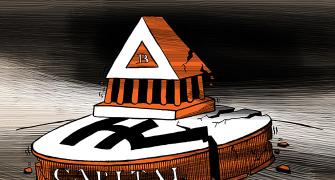'From lenders or purely fund raising point of view, money could more safely be deployed with the government entities like the NHAI and the IRFC than with private companies,' says Jyoti Mukul.

A crucial indicator of a company or an organisation’s prospects is its strategy towards creating productive assets.
For the Union government, that used to be defined by its planned expenditure.
But the distinction of planned and non-planned expenditure was removed in 2017.
Now, the Centre’s spending is categorised as capital and revenue expenditure.
Capital expenditure, when undertaken by companies, shows the level of private investment in the economy.
Any debt taken on this account is considered healthy so long as the companies are not overleveraged and are paying back on time.
Companies not going in for debt and relying only on equity financing is bad for a vibrant financial market.
Even for shareholders, it could mean the company is risking its capital and is being too aggressive by solely relying on equity financing.
So why is it that when governments take loan to fund capital expenditure, it raises question?
The National Highways Authority of India and the Indian Railways are two government organisations that take care of a major part of transport infrastructure of the country.
While the railway accounts for around 20-25 per cent of the Centre’s total capital expenditure, the ministry of road transport and highways constitutes another 7-8 per cent.
Both earn some revenue but are also dependent on the Union government for meeting their expenses.
These sectors require huge investment and constant maintenance.
The Railways have to additionally bear some manpower cost quite like public sector undertakings and unlike other government departments.
Over the years, however, both the NHAI and the Railways have become heavily dependent on borrowings.
In the current year, for instance, NHAI’s borrowing target has been hiked by 21 per cent.
It has an approval to raise Rs 75,000 crore during the year while government support is just Rs 36,691 crore.
NHAI’s cumulative borrowings stood at Rs 184,500 crore at the end of March 2019.
If one looks at the Railways, long-term borrowings of its arm, Indian Railway Finance Corporation, stood at Rs 114,854 crore while short-term was Rs 4,96,679 crore on March 2018, according to the latest available data from its annual report.
There are two reasons for such heavy borrowings by these organisations - less-than-required government fund infusion in these sectors over the years, made worse by tepid private investment.
In the case of NHAI, the share of government funding in its total expenditure was a little over 75 per cent in FY08 but has fallen to around 25 per cent.
For the Railways, however, funds from the government that flow in as gross budgetary support constitute a higher chunk of 41 per cent of its capital expenditure.
The Railways also has the advantage of a much larger resource generation capacity since it is essentially a commercial organisation.
The NHAI, by contrast, does not run any commercial operation.
Even the toll income that comes to it from highways built with government funding or the engineering, procurement and construction (EPC) model are used for maintenance work.
Though the public-private partnership route has in the past been more successfully exploited by the NHAI than by the Railways, the lack of investment appetite forced the government to keep funding road construction.
The natural fallout was an increase in borrowings which is now forcing the NHAI to revisit the build-operate-transfer (BOT) route.
A multi-pronged approach to road construction - where the platter of offerings would include BOT, toll-operate-transfer, infrastructure investment trust and hybrid annuity - has been envisaged.
This is expected to ease the need to borrow.
Analysts may have forced the Prime Minister’s Office to ask the highway ministry to look at asset monetisation rather than road construction, but this is nothing new for Union road minister Nitin Gadkari since he himself had been talking about it for almost two years now.
But should this mean that the government should move away from government funded route of EPC?
The industry itself wants the government to continue with EPC.
The reason being that the liquidity provided by government funds to these companies is crucial in these times.
From lenders or purely fund raising point of view, money could more safely be deployed with the government entities like the NHAI and the IRFC than with private companies.
Nonetheless, these organisations should go slow on borrowings and not venture into high cost projects.
However, considering the slowdown, any spending cut on their part will hit the sector hard.
Photograph: PTI Photo










